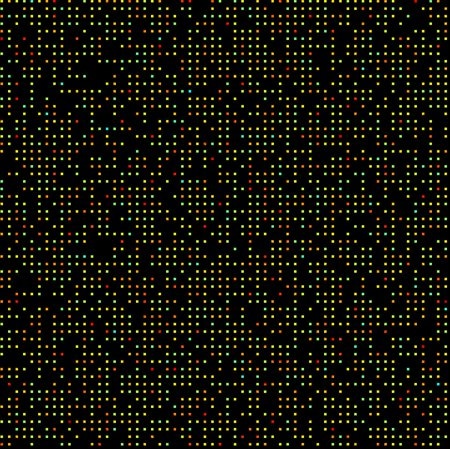Apr 2 2019
Doctors need to know something about the traits of cancer from which a patient is suffering to be able to devise the best treatment for the patient. But one of the extreme challenges in treating cancer is that not all cancer cells are the same. Even within the same tumor, cancer cells can vary in their behavior, genetics, and susceptibility to chemotherapy drugs.
 A scanned image of a grid containing one cancer cell and some blood inside each colored box. The color of the boxes indicates the amount of oxygen dissolved in the blood. (Image credit: Caltech)
A scanned image of a grid containing one cancer cell and some blood inside each colored box. The color of the boxes indicates the amount of oxygen dissolved in the blood. (Image credit: Caltech)
Cancer cells are usually a lot more metabolically active compared to healthy cells, and certain insights into the behavior of cancer cell can be collected by examining its metabolic activity. But obtaining a correct assessment of these features has proven hard for scientists. Several approaches, including position emission tomography (PET) scans, fluorescent dyes, and contrasts have been employed, but each has disadvantages that restrict their practicality.
Caltech's Lihong Wang trusts he can achieve better through the use of photoacoustic microscopy (PAM), a method in which laser light triggers ultrasonic vibrations in a sample. Those vibrations can be used to blood vessels, image cells, and tissues.
Wang, Bren Professor of Medical Engineering and Electrical Engineering, is using PAM to enhance the current technology for measuring the oxygen-consumption rate (OCR) in partnership with Professor Jun Zou at Texas A&M University. That current technology takes a number of cancer cells and puts them each into separate "cubbies" filled with blood. Cells with greater metabolisms will consume more oxygen and will lower the level of blood oxygen, a process which is monitored by a miniature oxygen sensor set up within each cubby.
This technique, like those formerly stated, has flaws. To obtain a significant sample size of metabolic data for cancer cells would require scientists to implant numerous sensors into a grid. Moreover, the presence of the sensors inside the cubbies can change the metabolic rates of the cells, making the collected data to be erroneous.
Wang's enhanced version eliminates the oxygen sensors and instead employs PAM to measure the oxygen level in each cubby. He does this using laser light that is tweaked to a wavelength that the hemoglobin in the blood absorbs and changes into vibrational energy—sound. As a hemoglobin molecule gets more and more oxygen, its ability to absorb light at that wavelength varies. Thus, Wang is able to establish how oxygenated a sample of blood is by "listening" to the sound it makes when the laser illuminates it. He terms this single-cell metabolic photoacoustic microscopy (SCM-PAM).
In the latest paper, Wang and his co-authors reveal that SCM-PAM signifies a major improvement in the ability to evaluate the OCR of cancer cells. Using separate oxygen sensors to measure OCR limited scientists to examining about 30 cancer cells every 15 minutes. Wang's SCM-PAM enhances that by two orders of magnitude and allows scientists to examine about 3,000 cells in roughly 15 minutes.
We have techniques to improve the throughput further by orders of magnitude, and we hope this new technology can soon help physicians make informed decisions on cancer prognosis and therapy.
Lihong Wang, Professor, Caltech.
The paper, titled, "Label-free High-throughput Single-cell Photoacoustic Microscopy of Intratumoural Metabolic Heterogeneity," was published online by Nature Biomedical Engineering on April 1st. Wang's co-authors include Pengfei Hai and Toru Imai of Washington University in St. Louis and Caltech; Song Xu and Jun Zou of Texas A&M University, College Station; Ruiying Zhang of Washington University in St. Louis; and Rebecca L. Aft of Washington University School of Medicine and John Cochran Veterans Hospital.
The research was funded by the National Science Foundation and the National Institutes of Health.